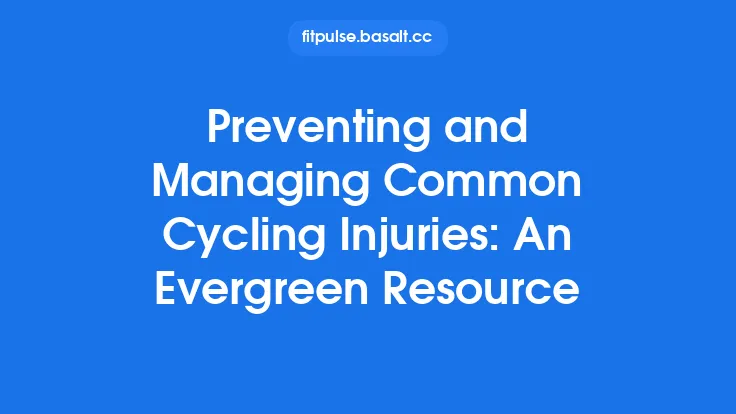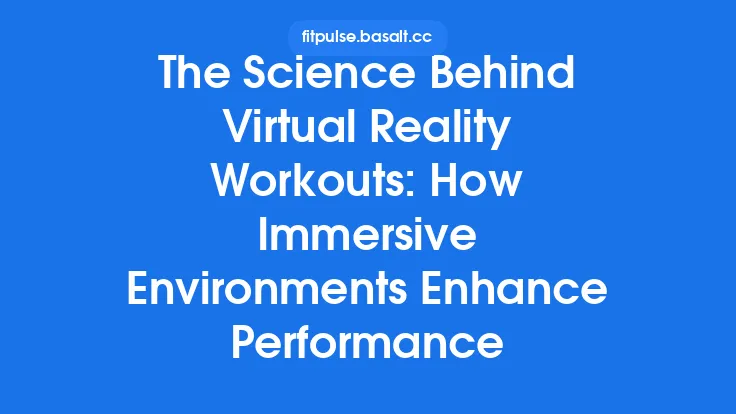Immersive fitness experiences—whether delivered through virtual reality (VR) headsets, augmented reality (AR) glasses, or mixed‑reality rigs—offer unprecedented engagement, but they also introduce unique safety challenges. Motion sickness, musculoskeletal strain, and accidental collisions can quickly turn an exciting workout into an uncomfortable or even hazardous event. This guide consolidates the most reliable, evergreen safety practices for anyone who uses immersive technology for exercise, from casual home users to professional trainers overseeing group sessions.
Understanding Motion Sickness in Immersive Environments
The Physiology Behind “VR Sickness”
Motion sickness in VR/AR arises when the brain receives conflicting sensory inputs: visual cues suggest movement while the vestibular system (inner ear) signals that the body is stationary, or vice versa. This sensory mismatch triggers nausea, dizziness, eye strain, and sometimes disorientation. The severity varies with individual susceptibility, session length, and the fidelity of the visual rendering.
Key Contributing Factors
| Factor | How It Triggers Sickness | Mitigation Tips |
|---|---|---|
| Latency (delay between head movement and visual update) | Increases mismatch, causing the brain to “lag” behind perception. | Use hardware with ≤20 ms motion‑to‑photon latency; keep firmware and drivers up‑to‑date. |
| Field of View (FOV) | Extremely wide FOV can amplify peripheral motion cues, overwhelming the vestibular system. | Opt for moderate FOV (90–110°) for fitness apps; avoid “tunnel vision” modes that restrict peripheral awareness. |
| Frame Rate | Low frame rates (≤60 fps) produce choppy motion, heightening discomfort. | Aim for ≥90 fps; enable motion‑smoothing or reprojection features if available. |
| Motion Design | Rapid accelerations, abrupt direction changes, or “teleport” locomotion can be disorienting. | Favor smooth, linear motion; provide optional “comfort mode” with reduced acceleration. |
| User’s Physical State | Fatigue, dehydration, or recent alcohol consumption exacerbate symptoms. | Encourage hydration, proper nutrition, and adequate rest before sessions. |
Physical Safety Precautions
Defining a Safe Play Area
- Clearance Zone – Minimum 2 m (6 ft) radius around the user, free of furniture, cords, and low‑lying objects.
- Floor Surface – Non‑slippery, level flooring (e.g., rubber gym mats) reduces the risk of slips and provides cushioning for impact.
- Boundary Systems – Activate the headset’s guardian or chaperone system; test it before each workout.
- Lighting – Adequate ambient lighting prevents eye strain and helps the headset’s inside‑out tracking maintain accuracy.
Protective Gear
- Footwear – Closed‑toe, supportive athletic shoes with good traction.
- Wrist/Elbow Supports – For high‑impact or repetitive motion workouts (e.g., boxing, rowing).
- Knee/Ankle Braces – Recommended for users with prior joint issues or when performing deep squats/lunges.
Ergonomic Setup
Headset Fit
- Weight Distribution – Adjust straps so the headset rests evenly on the forehead and the back of the head, minimizing pressure on the nose bridge.
- Interpupillary Distance (IPD) – Calibrate IPD to the user’s eyes; misalignment can cause eye strain and headaches.
- Lens Position – Ensure lenses are centered over the eyes; use spacer inserts if needed for glasses wearers.
Controller Placement
- Grip Comfort – Choose controllers with ergonomic handles; consider silicone grips for sweat resistance.
- Button Mapping – Assign frequently used actions to easily reachable buttons to avoid awkward wrist extensions.
Audio Considerations
- Spatial Audio – Use headphones that provide accurate directional cues without excessive volume, preserving situational awareness.
- Ambient Sound – Keep a low level of background music or white noise to maintain balance and prevent isolation from real‑world hazards.
Pre‑Workout Preparation
- Medical Clearance – Users with cardiovascular, neurological, or musculoskeletal conditions should obtain physician approval before engaging in immersive fitness.
- Warm‑Up Routine – Perform a 5‑10 minute dynamic warm‑up outside the headset (e.g., arm circles, leg swings) to increase blood flow and reduce injury risk.
- Hydration Check – Drink 200–300 ml of water 20 minutes before starting; keep a water bottle within arm’s reach.
- Device Calibration – Run the headset’s tracking calibration and verify controller battery levels (>80 %).
- Comfort Settings – Enable any built‑in “comfort” options (e.g., reduced motion blur, vignette during rapid turns) before launching the workout.
In‑Session Monitoring
Real‑Time Physiological Tracking
- Heart Rate – Use chest straps or optical sensors integrated into the headset to stay within target zones (e.g., 60–80 % of max HR).
- Motion Capture – Leverage built‑in skeletal tracking to detect abnormal joint angles or excessive range of motion.
- Feedback Loops – Set up audible or haptic alerts when the user exceeds safe thresholds (e.g., “slow down” cue if cadence spikes).
Visual and Auditory Cues
- Boundary Alerts – Ensure the system provides a clear visual flash and a gentle tone when the user approaches the play‑area limit.
- Posture Reminders – Periodic prompts (“keep shoulders relaxed,” “maintain neutral spine”) help maintain proper form.
Session Duration
- Time Limits – For beginners, limit continuous immersive activity to 15–20 minutes, followed by a 5‑minute break.
- Progressive Build‑Up – Increase session length by no more than 10 % per week to allow adaptation.
Post‑Workout Recovery
- Cool‑Down – Conduct a 5‑minute low‑intensity stretch within the headset or offline to gradually lower heart rate.
- Screen Time Rest – After a session, give the eyes a 20‑second break for every minute of VR exposure (the “20‑20‑20” rule).
- Hydration & Nutrition – Re‑hydrate and consume a protein‑carb snack within 30 minutes to aid muscle recovery.
- Equipment Care – Wipe lenses with a microfiber cloth, disinfect controllers, and store the headset in a protective case to prevent damage and maintain hygiene.
Special Considerations for Different Populations
| Population | Specific Risks | Tailored Guidelines |
|---|---|---|
| Children (≤12 yr) | Smaller stature, developing vestibular system, higher susceptibility to motion sickness. | Use child‑size headsets, limit sessions to ≤10 min, supervise at all times, and avoid high‑impact movements. |
| Older Adults (≥65 yr) | Reduced balance, slower reaction times, potential cardiovascular limitations. | Prioritize seated or low‑impact workouts, ensure sturdy support (e.g., chair or rail), and monitor heart rate closely. |
| Pregnant Users | Altered center of gravity, increased joint laxity. | Favor low‑impact, seated activities; avoid rapid directional changes and high‑intensity intervals. |
| Users with Visual Impairments | Difficulty focusing on stereoscopic depth cues. | Choose headsets with adjustable focus lenses, enable high‑contrast UI, and consider audio‑first workout designs. |
| Individuals with Motion Sensitivity | Chronic vestibular disorders (e.g., Ménière’s disease). | Start with “static” experiences (no locomotion), use external reference points, and keep session length minimal. |
Equipment Maintenance and Hygiene
- Lens Care – Clean lenses with a lens‑safe solution; avoid abrasive materials that could scratch the optics.
- Controller Sanitization – Use alcohol‑based wipes on exterior surfaces; allow components to dry completely before storage.
- Battery Management – Follow manufacturer recommendations for charging cycles; store spare batteries in a cool, dry place.
- Firmware Updates – Regularly install updates that often include latency improvements and safety patches.
- Physical Inspection – Check straps, padding, and cables for wear; replace any frayed or cracked components promptly.
Emergency Procedures and First Aid
- Immediate Stop – All immersive fitness platforms should feature a “panic button” (hardware or voice‑activated) that instantly exits the virtual environment and restores the user’s view of the real world.
- Fall Response – Keep a soft mat or padded surface beneath the user; if a fall occurs, assess for head injury, loss of consciousness, or limb pain before allowing the user to stand.
- Motion Sickness Management – If nausea arises, have the user remove the headset, sit or lie down, sip water, and breathe slowly. Over‑the‑counter anti‑emetics can be used under medical guidance.
- First‑Aid Kit – Maintain a stocked kit (bandages, antiseptic wipes, ice packs) within arm’s reach of the workout area.
- Incident Log – Record any adverse events (date, time, symptoms, equipment used) to identify patterns and adjust safety protocols.
Best Practices for Developers and Trainers
- Design for Comfort – Implement optional “comfort modes” (reduced acceleration, vignette, teleportation) and allow users to toggle them at any time.
- Clear UI/UX – Use high‑contrast, large‑font prompts for safety warnings; avoid clutter that can distract from physical movement.
- Progressive Difficulty – Structure workouts with graduated intensity, providing explicit cues when moving to the next level.
- Data Transparency – Offer users access to real‑time metrics (heart rate, motion range) and post‑session summaries to encourage self‑monitoring.
- Inclusive Testing – Conduct usability testing across age groups, body types, and vestibular sensitivities to uncover hidden safety issues.
Summary
Immersive fitness holds the promise of engaging, personalized workouts, but its benefits are realized only when safety is built into every layer—from hardware selection and environment setup to session design and post‑exercise care. By understanding the physiological roots of motion sickness, establishing a well‑cleared and ergonomically sound play area, monitoring physiological signals in real time, and tailoring protocols to individual needs, users can enjoy the excitement of VR/AR exercise while minimizing the risk of nausea, injury, or long‑term strain. Consistent equipment maintenance, clear emergency procedures, and a commitment to user‑centric design further cement a culture of safety that will sustain the growth of immersive fitness for years to come.





